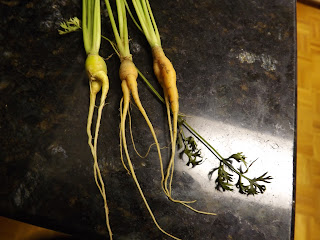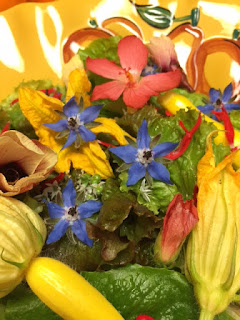I believe in the power of heirloom seeds. Although it may take a few growing seasons before some crops adapt to a new environment, if the gardener saves the best seed specimens for subsequent plantings, these smart plants will thrive in a variety of growing conditions, produce abundantly and develop resistance to pests. At Heart & Sole Gardens, two bean varieties are excellent examples of how heirloom seeds acclimate to geographic areas.
 |
| Granny's Beans, Growing in 2015 from Pre-1985 Seed |
For many years, my maternal grandmother, Lora Bolick Minton, grew a large vegetable garden and saved seeds from her plants. Most of the seeds she planted were inherited from immigrant ancestors who brought them from Germany. After my grandmother died, in 1986, my parents stored her seeds in their freezer and when I cultivated a large 2008 garden, they offered me the seeds. I planted Granny's beans in 2009 and, even though these seeds were dormant for almost twenty-five years, the plants thrived and I harvested bushels of Mountaineer White Half Runner beans. Despite the abundant yield, I made a terrible mistake.
 |
| Pickled Dilly Beans, A Favorite Family Treat |
 |
| Good Friday Planting Restored Pure Seed Stock |
 |
| Ted's Butter Beans |
 |
| Beautiful Butter Bean Blossoms |
When I was a child, my grandmother picked bushels of green beans every summer. I remember the snap, snap of beans as my grandmother, mother and aunt, prepared them for canning and the distinctive fragrance of cooking beans wafting from the kitchen. Our family ate canned green beans several times each week and I recall a trip to the coast when we made green bean sandwiches from the jars we packed for the trek. Although I use my canned beans for many recipes, the following is one that is a traditional family preparation. Now that I think about it, green bean sandwiches would be fun to try as an adult . . .
Southern Style Green Beans
*I remember beans from my childhood were cooked until almost mush, but for optimum flavor and texture, do not overcook.
3 slices smoked pork side meat (or thick bacon)
1 tablespoon vegetable oil (or olive oil)
1 medium onion, diced
2 quarts canned green beans or 3-4 pounds fresh snap beans, strings removed, washed and cut or broken to 2-3 inch pieces
Heat oil in a large Dutch oven and slowly cook meat until fat renders. Remove meat or leave in pot.
Add onion and stir to coat with oil/fat. Cook over low heat until tender, about 4 minutes.
Add beans and enough water to just cover.
Add 1/2 teaspoon sea salt, few grinds of black pepper, 1/4 teaspoon onion granules and 1/4 teaspoon garlic granules.
For a spicy kick, add a pinch of red pepper flakes.
Place lid on pot and cook until beans are tender.
*Vegetarians may omit pork and increase oil to 2 tablespoons.

















